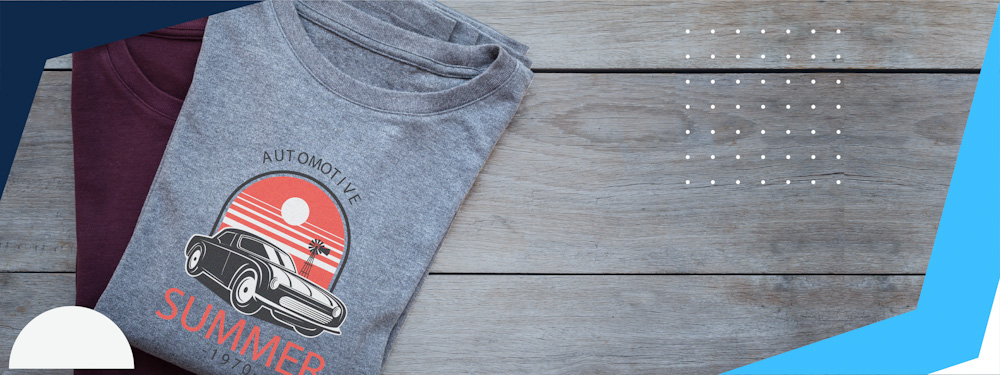What’s DTG printing and how does it work?
What’s pretreatment and why is it used in DTG printing?
is a clear liquid solution that’s applied to a garment before it goes to the printer. It plays two major roles during the DTG process. First, it prevents the ink from soaking into the garment by filling the space between the shirt fibers, creating a smooth surface to print on. Second, it allows the ink to adhere to the garment’s surface. It also helps with wash-fastness and ensures color vibrancy, which is key, especially for designs printed on dark garments. Pretreating is done by hand or a machine. We use the latter to ensure each garment gets just the right amount of solution every time.
What are the pros and cons of DTG printing?
The pros:
- Printed products have a natural feel – Because DTG printing embeds the ink into the fabric, the products are breathable and soft to the touch, making it difficult to distinguish between the ink and the fabric itself.
- Great image quality – DTG printing is able to recreate intricate details in virtually any color, which enables very detailed and vibrant high-quality results.
- Environmentally friendly – Today’s technology has paved the way for the use of eco-conscious inks and safe materials to be used for DTG printing.
- Print on Demand – DTG printing has opened up a whole industry of “on-demand” production, reducing the setup costs for one garment and allowing for an easy production process.
The cons:
- Doesn’t work on all types of fabrics – Garments used for DTG printing must be made of cotton to aid in the absorption of ink pigment for better quality.
- Printing time is a bit longer than screen printing.
How’s DTG printing different than screen printing?
While both DTG and screen printing will produce designs that hold up and wash well, there are several key differences. We’ve listed a few below. For more, check out our post on DTG versus screen printing.
- DTG doesn’t require much set-up, whereas screen printing requires separating artwork, creating screens for each color in the design, registering the screens on the press.
- The sky is the limit on the colors and designs used for DTG printing. However, that’s not the case for screen printing, which is best for simple designs with limited colors.
- There are no minimums for DTG orders. However, we recommend a minimum of 15 garments for screen printing orders due to the setup time required.
What garments do you recommend for the best results?
We’re asked this all the time. While Scalable Press has nearly 100 shirts that work for DTG printing, we’ve narrowed the list to our top 3 favorites. Each of these has a soft hand-feel and work great for DTG printing:

The Bella + Canvas Unisex T
The Bella + Canvas 3001 feels soft and light, with just the right amount of stretch. It’s super comfortable with a cut that flatters men and women.
- Solid colors are 100% combed and ring-spun cotton
- Ash color is 99% combed and ring-spun cotton, 1% polyester
- Heather colors are 52% combed and ring-spun cotton, 48% polyester
- Athletic and Black Heather are 90% combed and ring-spun cotton, 10% polyester
- Heather Prism colors are 99% combed and ring-spun cotton, 1% polyester
- Fabric weight: 4.2 oz/y² (142 g/m²)
- Pre-shrunk fabric
- 30 single
- Tear-away label
- Shoulder-to-shoulder taping
- Side-seamed

The Next Level 3600 Men’s Tee
This Next Level 3600 is soft, form-fitting, and pre-shrunk, so it will maintain its shape after washing.
- 100% combed ring-spun cotton
- Heather Grey is 90% cotton, 10% polyester
- Fabric weight: 4.3 oz/y² (145.8 g/m²)
- 32 singles
- Pre-shrunk
- Tear-away label

The American Apparel 2001 Tee
The American Apparel 2001 is a classic. Made with fine jersey cotton construction, so it’s extremely soft and comfortable to wear. What’s more, it holds color and shape well after multiple washings.
- 100% combed ring-spun cotton
- Heather grey is 90% cotton, 10% polyester
- Fabric weight: 4.3 oz/yd² (146 g/m²)
- Shoulder-to-shoulder taping
- Double-stitched sleeves and bottom hem
How well do DTG prints hold up after multiple washes?
DTG prints will remain just as bright and soft and won’t crack when properly cared for. Here are a few tips to ensure your garments will last a long time:
- Wash inside out with cold water with similar colors using a gentle cycle
- If ironing is necessary, iron inside-out on the lowest setting
- Tumble dry low or hang-dry
- Avoid using bleach and do not dry clean
What equipment do you use for DTG printing?
We use the Brother GTXpro, which is known for its quality and speed. Each machine has 2 print heads, 8 ink channels, and a print resolution of 1200 x 1200 dpi. The GTXpro has a maximum print size of 16″ x 21″ inches, the largest of any Brother printer, to allow for bigger, bolder designs. What’s more, it can print most items in a single pass. As for inks, we use Innobella Textile. These are water-based pigment inks that are vibrant, durable, and can stand up to multiple washes.
How do I place a DTG order with Scalable Press?
Placing DTG orders with us is easy. Just head on over to scalablepress.com, register for a free account, or log in to get started. If you need a little help to get things going, check out our handy video tutorial, which provides a step-by-step guide to placing DTG orders with us.




